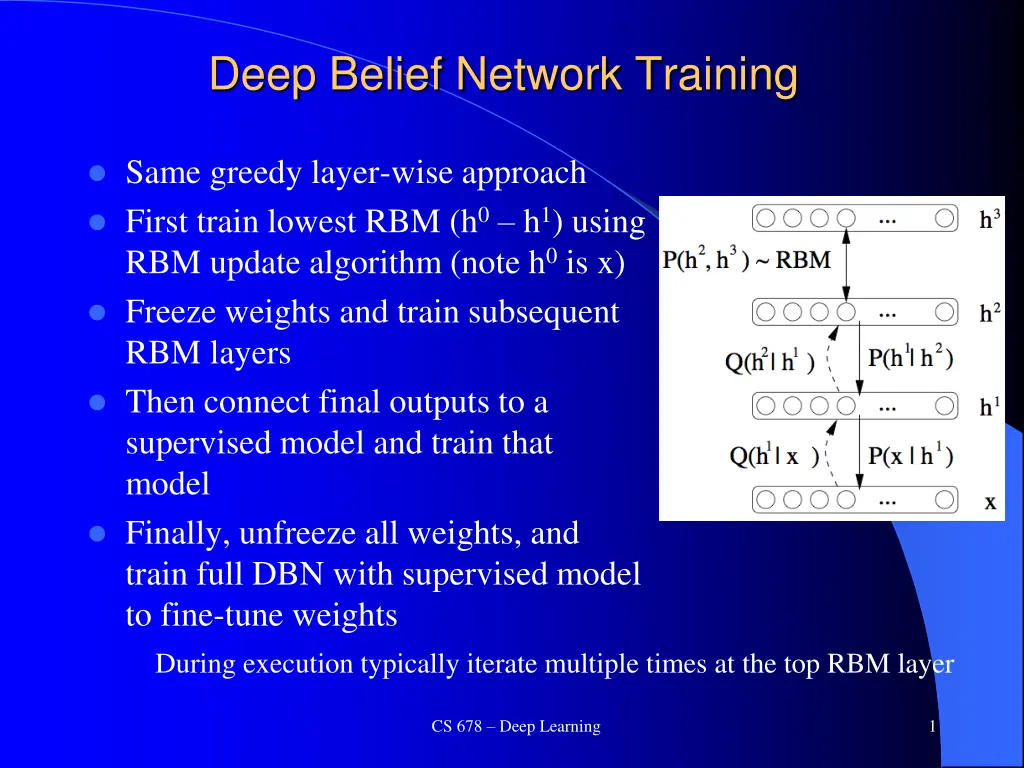
Deep Training Techniques for Efficient Networks
Learn how to train a Deep Belief Network (DBN) using a layer-wise approach, freezing weights, connecting to a supervised model, and fine-tuning for optimal performance. Discover how DBNs can be used as generative models and uncover insights on learning notes and lateral connections in RBMs.
Download Presentation

Please find below an Image/Link to download the presentation.
The content on the website is provided AS IS for your information and personal use only. It may not be sold, licensed, or shared on other websites without obtaining consent from the author. If you encounter any issues during the download, it is possible that the publisher has removed the file from their server.
You are allowed to download the files provided on this website for personal or commercial use, subject to the condition that they are used lawfully. All files are the property of their respective owners.
The content on the website is provided AS IS for your information and personal use only. It may not be sold, licensed, or shared on other websites without obtaining consent from the author.
E N D
Presentation Transcript
Deep Belief Network Training Same greedy layer-wise approach First train lowest RBM (h0 h1) using RBM update algorithm (note h0is x) Freeze weights and train subsequent RBM layers Then connect final outputs to a supervised model and train that model Finally, unfreeze all weights, and train full DBN with supervised model to fine-tune weights During execution typically iterate multiple times at the top RBM layer CS 678 Deep Learning 1
Can use DBN as a Generative model to create sample x vectors 1. Initialize top layer to an arbitrary vector Gibbs sample (relaxation) between the top two layers m times If we initialize top layer with values obtained from a training example, then need less Gibbs samples 2. Pass the vector down through the network, sampling with the calculated probabilities at each layer 3. Last sample at bottom is the generated x value (can be real valued if we use the probability vector rather than sample) Alternatively, can start with an x at the bottom, relax to a top value, then start from that vector when generating a new x, which is the dotted lines version. More like standard Boltzmann machine processing. 2
DBN Learning Notes Each layer updates weights so as to make training sample patterns more likely (lower energy) in the free state (and non-training sample patterns less likely). This unsupervised approach learns broad features (in the hidden/subsequent layers of RBMs) which can aid in the process of making the types of patterns found in the training set more likely. This discovers features which can be associated across training patterns, and thus potentially helpful for other goals with the training set (classification, compression, etc.) Note still pairwise weights in RBMs, but because we can pick the number of hidden units and layers, we can represent any arbitrary distribution CS 678 Deep Learning 4
DBN Notes Can use lateral connections in RBM (no longer RBM) but sampling becomes more difficult ala standard Boltzmann requiring longer sampling chains. Lateral connections can capture pairwise dependencies allowing the hidden nodes to focus on higher order issues. Can get better results. Deep Boltzmann machine Allow continual relaxation across the full network Receive input from above and below rather than sequence through RBM layers Typically for successful training, first initialize weights using the standard greedy DBN training with RBM layers Requires longer sampling chains ala Boltzmann Conditional and Temporal RBMs allow node probabilities to be conditioned by some other inputs context, recurrence (time series changes in input and internal state), etc. CS 678 Deep Learning 5
Discrimination with Deep Networks Discrimination approaches with DBNs (Deep Belief Net) Use outputs of DBNs as inputs to supervised model (i.e. just an unsupervised preprocessor for feature extraction) Basic approach we have been discussing Train a DBN for each class. For each clamp the unknown x and iterate m times. The DBN that ends with the lowest normalized free energy (softmax variation) is the winner. Train just one DBN for all classes, but with an additional visible unit for each class. For each output class: Clamp the unknown x, initiate the visible node for that class high, relax, and then see which final state has lowest free energy no need to normalize since all energies come from the same network. Or could just clamp x, relax, and see which class node ends up with the highest probability See http://deeplearning.net/demos/ CS 678 Deep Learning 6
MNIST CS 678 Deep Learning 7
DBN Project Notes To be consistent just use 28 28 (764) data set of gray scale values (0-255) Normalize to 0-1 Could try better preprocessing if want, but start with this Small random initial weights Last year only slight improvements over baseline MLP (which gets high 90's) Best results when using real net values vs. sampling Fine tuning helps Parameters Hinton Paper, others do a little searching and e-mail me a reference for extra credit points Still figuring out CS 678 Deep Learning 8
Conclusion Much recent excitement, still much to be discovered Biological Plausibility Potential for significant improvements Good in structured/Markovian spaces Important research question: To what extent can we use Deep Learning in more arbitrary feature spaces? Recent deep training of MLPs with BP shows potential in this area CS 678 Deep Learning 9


















